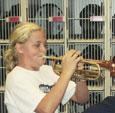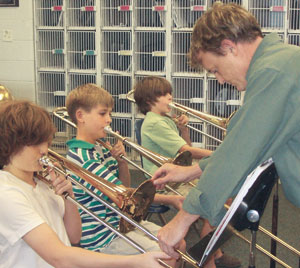
Editor’s Note: In the September issue RoAnn Romines and George Hayden described how they teach fifth- and sixth-grade woodwind students. In the final part of this article, they share their ideas for teaching new students studying brass and percussion.
Brass for Beginners
George Hayden: For fifth-grade students, playing a brass instrument begins with selecting either a trumpet or trombone. Even though this is an important process that takes time, no one ever showed RoAnn or me what to do. We simply learned on our own. The process starts by having students buzz their lips, which is easy for most prospective players because it is similar to the sound children make as they play with toy trucks and cars.
We have them make the buzzing sound on a specific pitch, concert F. Next, they use a mouthpiece and once again try to buzz concert F. All trumpet players begin with 5C mouthpieces, and trombone players use 6.5 ALs. For both trumpet and trombone, 50% of the mouthpiece should cover the upper portion of the lip and 50% should cover the lower proportion. Encourage students to play many pitches or pick a favorite song and try to buzz it. Everyone thinks this is fun. Here in Tennessee, most young boys and girls start buzzing “Rocky Top.” When the class plays together, however, we strive to play one pitch.
Next, students try to play both a trumpet and a trombone, regardless of their initial interest or inclination, with the goal being to play a concert F. The director should keep the process simple by holding the instrument for the first few days. Between the two instruments, concert F seems to be a little easier for most beginners on trombone, which should help your low brass numbers.
If a student wants to play trumpet but cannot hit concert F after multiple tries over several days, then we steer him towards trombone, a woodwind instrument, or percussion. Our goal for instrumentation is to have an approximate 50/50 ratio between trumpets and trombones, but the most important goal is to find out which instrument best suits each student.
RoAnn Romines: Once students make a selection, we ask parents to acquire a good-quality instrument from a reputable band instrument company using a rental or rent-to-own program; this gives the family more flexibility should their child need to change instruments. It may take several days for the process to unfold, meantime there is still plenty to do.
George: It is ideal to have every student acquire a trumpet or trombone before lessons begin so everyone learns basic skills – assembling, holding, and carrying the instrument – at the same time. If the last instrument arrives a few days late, we simply reteach the concepts.
During the interim students spend a few days buzzing long tones and playing rhythms on flash cards using an assortment of extra brass mouthpieces stored in the band room. Sometimes we pass out percussion instruments and work on rhythm until the instruments arrive, and we also begin talking to families about the value of private instruction.
1st- and 2nd-Year Brass Curriculum
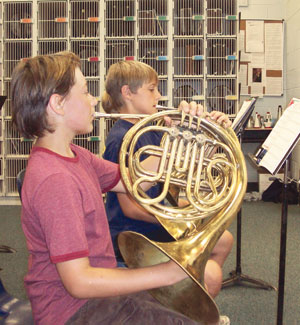 George: Once everyone has instruments, we start by telling students to never stop buzzing mouthpieces (it is especially helpful when discovering the tessitura of a new piece), and we stress singing from the first day of brass class. In addition to singing, humming is especially valuable for brass players because it more closely resembles mouthpiece buzzing than singing. Initially, lessons focus on posture, assembling the instrument, holding and carrying it correctly, and caring for it.
George: Once everyone has instruments, we start by telling students to never stop buzzing mouthpieces (it is especially helpful when discovering the tessitura of a new piece), and we stress singing from the first day of brass class. In addition to singing, humming is especially valuable for brass players because it more closely resembles mouthpiece buzzing than singing. Initially, lessons focus on posture, assembling the instrument, holding and carrying it correctly, and caring for it.
Brass instruments are easy to assemble, just watch to be sure students handle the trombone slide from the ends, and try to keep all brass players from making a popping sound with the mouthpiece. The most important concept for a holding position for brass is that the left hand holds the instrument and the right hand plays it.
To hold a trombone, the right hand grasps the slide brace at the bottom using the thumb and one or two fingers; warn students to never grab the slide with the fist or whole hand. As for trumpet, students place the right thumb between the first and second valve casings and play on the pads or tips of the fingers; the fingers of the right hand should move fluidly and comfortably, avoiding “paddle” fingers.
The students and the director should perform their instrument aerobics daily, moving the instrument front and back, up and down, side to side, in counterclockwise circles and clockwise circles, with the instrument in both the up position and the down position with the left hand only. For the left hand on trombone, I tell students to imagine shaking hands with the trombone brace and then place three fingers in the box and placing the index finger along side the mouthpiece as close as they are able. The trumpeter’s left hand should grasp the valve casings. I recommend placing the pinkie below the third slide and the middle finger (it’s the longest) in the third slide ring. Be sure trumpet players use their third slide for low D and low C# from day one. Good playing position or horn carriage includes holding the instrument slightly downward with the neck and shoulders relaxed. Finally, before anyone plays a note, teach students about daily care, short-term care, and long-term care of their instruments.
RoAnn: The first-year curriculum for fifth-grade brass students begins with long tones. We teach students to use an audible breath, filling the lungs with air while pushing the stomach muscles outward. We play games and have contests to see who can sustain notes the longest with the goal of performing concert F for one to two minutes using a steady tone that has no deviation or fluctuation. Students may take a breath when they need it, but they have to maintain a correct embouchure.
I have tried beginning brass on concert B flat and for months fought to get students up to concert F, and I have started them on concert D, which works fine. Beginning on concert F, however, easily paves the way for students to learn four more notes descending to concert B flat. This year every brass student could play concert F within four days of starting the instrument, and all 80 brass players could play four more notes one day later.
George: Students learn correct tonguing early in lessons so they don’t simply blow aimlessly or use a breath attack. Actually, we introduce tonguing on the first or second day when students begin mouthpiece buzzing, by using the tip of the tongue on a dah syllable formed exactly where the back of the teeth meet the roof of the mouth. During class individual students match pitches and play alone every day so that we can hear their work and remedy any problems. Next, we pair up two students whose tonguing matches, then we pair up sections whose tonguing matches followed by section leaders and then the band.
The method book is of secondary importance in our classroom. We are more concerned that students acquire skills to play an instrument well. Playing should be fun and its own reward, even if it is just one note. Once students can sustain long tones and tongue, they want to perform familiar songs such as “Merrily We Roll Along,” which is usually first, after which we delve into “Jingle Bells,” “Ode to Joy,” and a few others as the momentum picks up.
At this point, usually by October, students can play at least six notes; once the clarinets, flutes, and brass can go down the instrument, they are ready to begin the chromatic scale. We do not necessarily call it that or use the term partial because students do not understand that term; we say they are learning level 1. The brass students begin on low concert B flat and descend to concert E. We actually explain the physics of sound and point out the slides used for each fingering and position. Next, we present level 2, concert F descending to concert B, which they complete by November.
By learning level 1 and level 2, brass students can now play a concert F scale. As early as October and November, we want students exploring harmony parts, chord balance, and band arrangements. We are not ones to present the method book in order, from front cover to back cover, because most students want to sound grown up, and band arrangements address the ensemble skills to do that sooner rather than later.
George: In December some students are ready for level 3, concert B flat descending to concert F, thereby giving making the concert B flat scale possible.
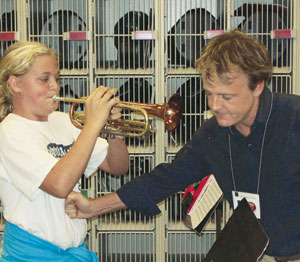
Sixth-Grade Studies
Meanwhile, sixth-grade brass students have completed level 4 and are working on or completing level 5, which goes up to high concert F. They learn that notes go beyond this, but they are not required to perform them, even though most are usually motivated to try. These students are also increasing their speed playing the chromatic scale.
By sixth grade we have introduced the brass students to all 12 major scales and 36 minor scales. The tuba players are learning when to use their slides, trombones have studied the tendencies of all the notes in their newly expanded range, and horn players continue to develop their ears, knowing when and how to use their right hand. A holiday concert becomes the focus of our teaching in December, when we also encourage students to play in churches and for family holiday reunions as well as continue with private lessons.
Learning Additional Scales
RoAnn: With the start of the new calendar year, fifth-grade brass students begin exploring level 3 lesson materials and some move on to level 4, playing concert D down to concert B flat. Goals for first-year brass students include putting the chromatic scale together, ascending and descending from their lowest note up to concert D as well as five major scales – concert F, B flat, A flat, C, and E flat.
Students also should know rhythms that include whole, half, dotted-half, quarter, dotted-quarter, and eighth-note combinations and tongue them correctly; 16th notes are also included. The difficulty of the rhythms increases for sixth-grade students. We use the months of January, February, March, and April to increase their range and expand the chromatic scale as well as learn major scales, more complex rhythms, and additional band arrangements for the spring concert.
George: The first-year brass curriculum concludes with the possibility of switching instruments at the end of the fifth grade. Similar to the process of finding an instrument at the beginning of the school year, students try other brass instruments as we guide them to the best choices. Occasionally the flute or trumpet sections will yield a good tuba player or students interested in horn, and often a good baritone player comes from the trumpet and trombone sections. Good horn players also come from the trombone or even the flute sections. It’s best to let students explore the instruments as we or a specialist on the instrument provide guidance. We use a summer band camp to switch over to these new instruments.
Training Percussionists
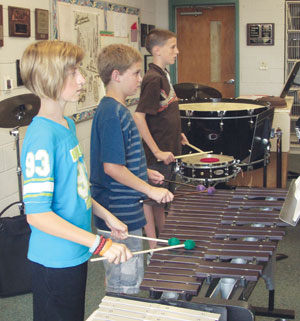 George: On the first day of band class as students are trying the various instruments and mouthpieces, some new band members will spend some time with drumsticks. We watch closely to identify those who can keep a steady beat and get a multiple bounce or buzz. It’s also helpful to find out who has had piano lessons because these students most often become good percussionists.
George: On the first day of band class as students are trying the various instruments and mouthpieces, some new band members will spend some time with drumsticks. We watch closely to identify those who can keep a steady beat and get a multiple bounce or buzz. It’s also helpful to find out who has had piano lessons because these students most often become good percussionists.
As each student learns how to hold the sticks, we find out how teachable and cooperative he is, his ability to listen, and his skill performing single and double strokes while keeping a steady beat. We teach students to find the exact spot where the stick gets the best bounce. This is usually between 2⁄3 and 3⁄4 down the stick. Keeping a steady beat is important because we use the percussion students as the metronome for the band.
There are usually so many students who want to play percussion that after several days of observing the group, we select only the best ones for the percussion section. To that extent you may need administrative support for controlling the ensemble’s instrumentation.
During the first few weeks of school while you are working with 20 to 80 students to establish good embou-chures, it is helpful to have some theory fun sheets at hand for the percussion section. Because we introduce many rudiments early, we sometimes allow our percussion students to quietly play on the carpet as we teach the winds.
RoAnn: As directors, we guide students to whichever instrument suits them the best, and most often they are happy because it is the one on which they have done the best. In the first year we emphasize note reading for mallet instruments, meaning percussionists play the same five major scales as the band, the chromatic scale, and all concert music. Percussionists are often asked to memorize their music when they play melody percussion. They should play all accessory instruments with the correct technique and know how to tune the timpani.
We do not require a bell kit or snare drum (the school provides all the percussion instruments). Instead, we want students to have a fairly comprehensive stick bag, which in the first year includes: medium timpani mallets; cord, yarn, and rubber mallets; concert band snare sticks; a pitch pipe; a set of triangle beaters; and the stick bag. In sixth grade students get the same sticks but in harder strength.
In the sixth grade we place more emphasis on snare drum technique, expecting students to polish the single stroke, single-stroke roll, double-stroke open roll, closed long roll, a ruff or drag or 3-stroke roll, 5-stroke roll, 7-stroke roll, 9-stroke roll, 10-stroke up to 15-stroke roll, ratamacue, flam, flam tap, flam accent, and paradiddle. When teaching rolls, we want students to think more in terms of basic strokes than counting individual taps. If the double bounce is engrained and comfortable, then the rolls will flow more smoothly.
Some Final Thoughts
George: Directors have to teach fundamental skills from the beginning and at a professional level. If students learn to play correctly, they can achieve a mature sound and perform high-quality music very quickly. Withhold no information that will help the ensemble sound good today. It does not take years to develop a high-quality sound in an ensemble, and you do not have to wait until high school to have a great sounding band. Chances are, if you wait until high school, you won’t have a great sounding high school band.
RoAnn: My mentors were fine directors who knew conducting, music history, and had extensive knowledge of each instrument. I can recall one mentor, Ray Cramer, whose knowledge continues to surprise me. While he ranks high in stature in our profession, he never shies away from sitting beside young band students, helping them review the fundamentals of their instruments with a genuine smile and caring for their success.
Music educators have to become private instructors on all the instruments. It is time to turn back the clock and return to the era when directors had the knowledge of professional players and teachers at their finger tips. Today many directors seldom play an instrument; many want to be only conductors and usually hire students to teach festival music.
As I did years ago, some directors fear of approaching students and giving them precise instructions to develop as trained musicians. This has weakened our ability to teach. Bands seem to have excelled across the globe, and many have changed the perception of arts in the school; but in years to come without good pedagogy, there will be no one to perform in bands or orchestras.
